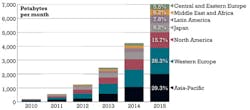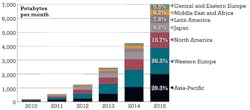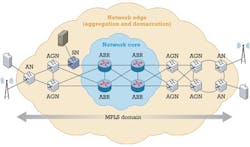Better backhaul with MPLS to the cell site
By NIR HALACHMI
Last year left North American mobile operators breathless. A wide adoption of smartphones, an exponential increase in smart devices (phones, tablets, game consoles, etc.), and rapid growth in smartphone applications compounded to make the mobile economy very dynamic. This mobile data usage and LTE deployment trials drove operators to address bandwidth shortages for mobile backhaul. More important, carriers had to face the realization that there is a true need for network change to support the troika of the new mobile economy tsunami: the convergence of mobile broadband, smart-device growth, and applications adoption.
The first quarter of 2012 was no different, with exciting applications like Instagram added to Android (later acquired by Facebook) or Apple announcing iPad3 with LTE connectivity. The rapid rise of smart devices and applications acceptance has been staggering – and it’s a global phenomenon (see Figure 1).
This rising data use has forced many mobile operators to massively invest in the network infrastructure to remain competitive and minimize churn, despite the fact that they can’t link this capital investment to increased revenues. Since data traffic is taking the higher share of the operator networks, there is a need to migrate mobile backhaul links to technologies that are more efficient in delivering these services as well as supporting the exponential growth in demand.
Change is in the air
Change is expected in almost all aspects of the network (perhaps beside the OSS/BSS) as a result of mobile services trends. To address the mobile broadband arena, carriers are adapting their networks through a number of mechanisms.
- RAN technology is moving forward with HSPA+, progressing to LTE and later LTE Advanced to accommodate up to 1 Gbps of downlink bandwidth. It is ironic that needs are changing so fast that while LTE is hardly commercialized, the next “advanced” generation is already being introduced. The fast pace of changing technologies may cause some operators to skip some technological generations while others will have an even bigger mix of technologies in their network.
- Mobile architecture is changing, with new concepts entering the market, such as “small cell” and “Cloud RAN.” The Evolved Packet Core (EPC) concept of flat, all-IP-based network also has caught on as LTE offerings mandate an end-to-end IP service. Such architecture will enable easier introduction and creation of services to support new business models, partnerships, and deployment options.
As a result of these changes, the mobile backhaul space is evolving as well. But unlike the RAN and packet core, which have been well defined by the 3GPP standards body, mobile backhaul traditionally hasn’t been defined at all, leaving operators with multiple technology options that offered different values and disadvantages.
FIGURE 1. The explosion in mobile bandwidth demand is a worldwide phenomenon, with a projected 92% CAGR from 2010 through 2015. Source: Cisco VNI Mobile, 2011
Fortunately, two standard bodies have noticed this problem and taken action. The Metro Ethernet Forum (MEF) now offers MEF22.1 and the new CE2.0 initiative, which promotes assured services; operations, administration, and maintenance; and network-to-network interconnection for Carrier Ethernet in the role of transport technology. Meanwhile, the Broadband Forum has created the TR-221 specifications for MPLS use in mobile backhaul networks.
Mobile backhaul requirements and options
Regardless of who provides mobile backhaul – the mobile operator itself, carrier’s carriers, utilities, bandwidth wholesalers, etc. – the requirements remain complex. For example, the typical mobile network combines multiple mobile technology generations like 2G, 3G, and 4G – all of which may coexist in the same cell or in different cells. Therefore, any backhaul network’s technology must offer a seamless migration path from TDM- to packet-based transport. Since each mobile macro cell will serve a large number of customers and may serve multiple base stations, operators must implement a transport protocol(s) that can provide high resiliency with sub-50-msec recovery time.
While there are few technological options for mobile backhaul, there is one common denominator: The most viable options are packet-based. Two options stand out: IP/MPLS and Layer 2 Carrier Ethernet. But as the network grows with more cell sites (both large and small), scalability can become a limiting factor in the use of Layer 2 Ethernet. Therefore, mobile backhaul providers should consider the benefits of IP/MPLS to the cell site for mobile backhaul.
Why extend MPLS to the cell site?
MPLS was created to combine the best of two worlds: ATM switching and IP routing. MPLS decouples the data plane from the control plane; it is a connection-oriented technology, so the connection has to be established prior to the data’s delivery. The MPLS control plane establishes the connection by signaling through each hop along the path. MPLS has significant traffic engineering capabilities that can be used to provide end-to-end service-level-agreement assurance. The MPLS data plane switches the packets based on MPLS labels that are carried inside a 32-bit MPLS header.
IP/MPLS is the de facto standard in the core today. While most edge and access networks are Layer 2, rapid changes due to the dynamic nature of mobile connectivity have forced operators to consider extending MPLS to the access and aggregation layers for easier control, resiliency, redundancy, and scalability.
MPLS at the edge of the network for mobile backhaul provides multiple advantages.
Maximizing scalability. MPLS is highly scalable. The 20-bit label enables more than one million label-switched paths (LSPs) per node. With each node changing the label and reusing labels, practically infinite LSPs can be supported. By using virtual private wire/line services (VPWS/VPLS), such a network can support thousands of customers and each customer can have a different logical topology. Hierarchical VPLS (H-VPLS) technology further increases scalability by segmenting the network into several fully meshed partitions, each concentrating into the VPLS hub (see Figure 2).
In contrast, Ethernet’s 12-bit VLAN tags support only 4,000 VLANs per switch. VLAN stacking (Q-in-Q) enables 4,000 customer VLANs to be carried in 4,000 provider VLANs. Since each customer is likely to use multiple VLAN IDs, the number of customers that can be supported is quite limited.
FIGURE 2. Virtual private line services (VPLS) network vs. hierarchical VPLS network.
Dynamic path creation. As mentioned, MPLS is a connection-oriented technology where control plane protocols (namely LDP and RSVP variants) handle path creation, starting from the source label edge router (LER), traversing the label switch routers all the way through the destination LER. These protocols base their path creation on the dynamic routing information exchanged between peers. The dynamic nature of MPLS minimizes service creation time while increasing network scalability since most of the work is done by dynamic protocols. When path creation can be accomplished by configuring only the end devices, manageability of the network becomes even easier.
Traffic engineering capabilities. MPLS provides strong traffic engineering capabilities embedded in the MPLS control protocols. The control plane can check and reserve bandwidth when establishing a path only after assuring the required committed information rate is available throughout the proposed path. The control plane also can mandate that traffic pass through specific nodes using strict rules or provide other protocols full dynamic control to ease the operational management of the network as changes occur.
Support of TDM and other legacy services. Because it is essentially a tunneling protocol, MPLS supports the transport of any service available today – TDM, Ethernet, Frame Relay, ATM, IP, etc. These services and protocols are encapsulated with MPLS labels, then switched to the destination, which may be another customer site or a service within the provider network. Taking into account the very strict timing requirements of TDM-based mobile technologies, traffic engineering can be used to assure the proper delivery of these services concurrently, combined with other less sensitive data services. MPLS with traffic engineering thus can guarantee dedicated bandwidth for the TDM-based mobile elements still in service to minimize the dreaded “iPhone dropped call” problems when bandwidth-hungry applications usurp the link capacity.
FIGURE 3. A “seamless” MPLS architecture decouples the service layer from the transport layer. This decoupling increases the flexibility to define and introduce new services by enabling service nodes to be placed at optimal locations in the network.
Designing the network for resiliency. As each cell site supports a large amount of end users, downtime translates into large revenue loss. Redundancy therefore must be part of the network design from the cell site, across the access and aggregation networks, and through the core. Primary and backup paths using VPLS technologies enable two levels of protection – at the tunnel level and service level – while restricting the use of backup bandwidth for failure scenarios only. If a failure occurs, MPLS Fast ReRoute and Bidirectional Forwarding Detection provide sub-50-msec switchover, using local repair techniques and signaling across the services to identify and initiate rerouting.
Seamless network improves service creation time
With the increasing deployment of small-cell technologies, the number of cells will grow exponentially. This trend has caused scalability issues and service creation challenges. The best way to improve service creation/delivery time is to have a network that operates independent of the services yet can support any service-deployment scenario. The network should not have transport boundaries that limit access to services.
A “seamless” MPLS architecture inherently has no boundaries and hence decouples the service layer from the transport layer. This decoupling increases the flexibility to define and introduce new services by enabling service nodes to be placed at optimal locations in the network rather than at the “boundary nodes.”
Although both the service and transport layers use the same MPLS packet formats, the difference is in the use of the MPLS control plane. Using the MPLS control plane end-to-end enables a management system to select the endpoints of the service then trigger signaling to set up the services across the network between the endpoints (see Figure 3).
Winning move
Moving MPLS to the cell site or aggregation point integrates access and aggregation networks with the core onto a single MPLS-managed network to create significant operational advantages. This network architecture is decoupled from the service architecture and incorporates intelligent switching closer to the cell site to optimize network resources and improve the network’s overall performance in an increasingly dynamic mobile-focused world. It also enables true customizable services, because quality of service parameters can be incorporated end-to-end. MPLS is manageable and scalable and can support any legacy services required to enable smooth migration to a pure IP network.
Factoring in the cost savings for bandwidth efficiency and network resiliency in an increasingly dynamic, bandwidth-hungry environment, MPLS enables additional revenues from customized services and cost savings through improved service creation. Combined, all these factors make a strong business case for driving MPLS to the cell site.
NIR HALACHMI is product manager, mobile backhaul products, at Telco Systems. He is responsible for the design and development of Telco Systems’s mobile backhaul offerings focusing on both cellular and wireless technology as well as QoS, data security, and communications.


